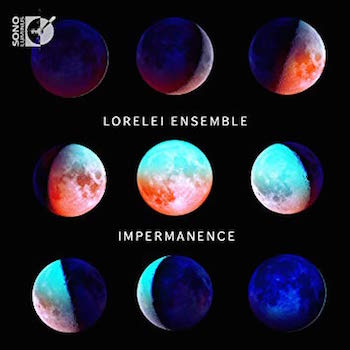Classical CD Review: Lorelei Ensemble’s “Impermanence” — Inspired
Lorelei Ensemble’s latest recording is awe-inspiring.
Impermanence, Lorelei Ensemble. Sono Luminus.
By Susan Miron

Impermanence, the spectacular new recording by the Lorelei Ensemble under the direction of Beth Willer, is even more impressive than their previous two, which also featured new works commissioned by this extraordinary group of 8 women’s voices. Founded ten years ago by Beth Willer, who is occasionally the 9th voice, Lorelei Ensemble has devoted themselves to radically expanding the repertoire for women’s voices, often having their commissions published to share with others who might be inspired to start a women’s vocal ensembles of their own. Lorelei’s reputation has grown exponentially the past few years, from being a largely Boston-based group to a frequently touring ensemble, a favorite guest of the Boston Symphony Orchestra, and many excellent chamber music groups.
Lorelei’s gorgeous voices (sopranos Sarah Brailey, Margot Rood, and Sonja Tengblad; mezzo-sopranos Christina English, Clare McNamara, and Sophie Michaux; contraltos Emily Marvosh and Stephanie Kacoyanis) specialize in “repurposing” early (medieval, Renaissance) compositions — most of which was originally written for male voices — and cutting-edge new music. This approach demands considerable creativity; as Lorelei’s director Beth Willer writes: “In the process of recording, we found ourselves ‘continuously becoming’ as we grappled with a repertoire that invited constant re-imagination.”
The first thing one notices about this CD is the high quality of the sound served up by Sono Luminus. The next unusual feature, which upends conventional ideas of how an album’s playlist should be arranged, is that pieces by two contemporary composers (Toro Takemitsu and Peter Gilbert) are interspersed among compositions written in the twelfth century as well as in several ancient manuscripts. This set-up is initially a bit jarring but, surprisingly, after several hearings, the unorthodox arrangement works, perhaps because the choices are unified by their underlying themes of the ephemeral evanescence of existence.
Impermanence opens with a stately “Portum in ultimo” from Codex Calixtinus (c. 1160-1173, Spain). It concludes, “Lead us, patron saint, that we may prayerfully enter paradise.” The beauty of this performance made me yearn for an entire album of Lorelei performing early music, but this short piece was immediately followed by one of two vocalises (no words) by the great Japanese composer Toru Takemitsu (1930-1996), itself followed by the first three of eight brief Japanese waka poems, miniature musical moments from Peter Gilbert (born 1975), a Lorelei commission that features a different singer in each movement. Gilbert writes in the CD’s notes: “Translated as moon viewing, ‘Tsukimi’ is a traditional Japanese celebration of the full moon dating back to the Heian period (roughly 800-1200 AD)… a great era for Japanese literature that saw the revival of native waka poetry.” Gilbert deftly generates alluring images — of the moon and waves, hanging clouds, the sea and the sky — out of otherworldly declamations, glissandi, and long lines of fluid vowels.

Lorelei Ensemble. Photo: courtesy of the artist.
Four ravishing pieces follow, two by the famed Early Renaissance composer Guillaume Du Fay (1397-1474) and two from the Turin Codex (15 century, Cyprus/Italy). They arrive as if they dropped in from a different universe. Again, I felt as if I could listen to the Lorelei Ensemble sing this seductive, transcendent music non-stop. Du Fay’s works, written between 1420 and 1440 in Northern Italy, are usually sung by men, but they work astonishingly well repurposed for perfectly pitched female voices.
Beth Willer explains that The Turin Codex (which included plainchant, polyphonic mass settings, dual-texted motets, and secular songs) “bore the influence of not only Greek, Italian and French cultural groups, but also Armenian and Turkish.” But one needn’t know a thing about the cultural origins of this glorious unaccompanied vocal music to appreciate just how ravishingly beautiful it is — and how meticulously it is sung. Two more of Gilbert’s songs and the second Takemitsu vocalise end this awe-inspiring recording. Even its cover art is an eyeful.
Susan Miron, a harpist, has been a book reviewer for over 20 years for a large variety of literary publications and newspapers. Her fields of expertise were East and Central European, Irish, and Israeli literature. Susan covers classical music for The Arts Fuse and The Boston Musical Intelligencer.
